
|

|
| New Testament, 20 BC-100 AD | ||||||||||||||||||||||||||||||||||||||||||||||||||||||||||||||||||||||||||||||||||
|
CLICK ON IMAGES FOR A LARGER IMAGE TO OPEN |
|||||||||||||||||||||||||||||||||||||||||||||||||||||||||||||||||||||||||||||||||
|
||||||||||||||||||||||||||||||||||||||||||||||||||||||||||||||||||||||||||||||||||
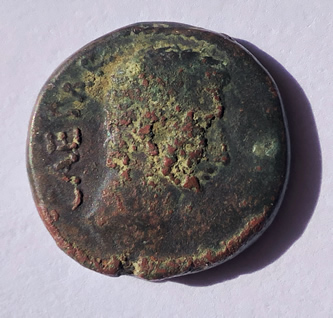 |
27 BC-14 AD Coin of Ceasar Augustus < The front or obverse side says "CAESAR" with an image of Caesar Augustus
The reverse side of a Ceasar Augustus coin with title "AUGUSTUS" written in a wreath on the back of this bronze coin. > |
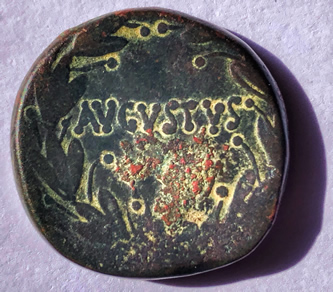 |
|
 |
< 20-120 AD Roman Bronze Eagle Head for Staff Handle > |
 |
|
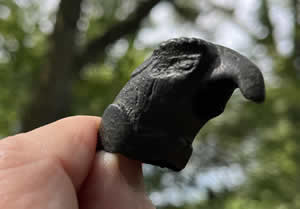 |
< 20-120 AD Roman Bronze Eagle Head for Staff Handle > |
 |
|
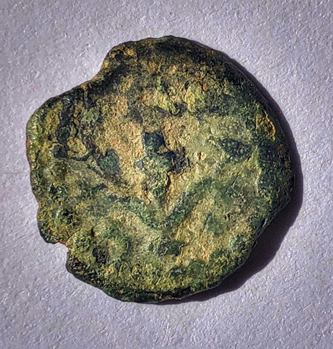 |
37-4 BC minted by Herod the Great in Judea < The obverse side shows an anchor on the obverse side with the inscription
The reverse side shows two cornucopias. > |
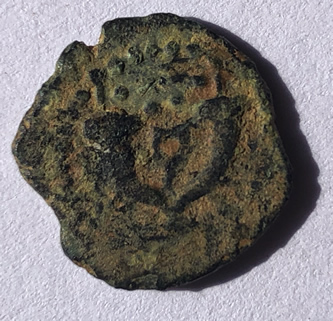 |
|
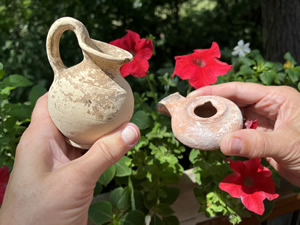 |
< 30 AD - Hellenistic Olpe jar that held oil or wine from 200-1 BC with a 63 BC-100 AD Herodian Oil Lamp
New Testament oil lamp likely used in 30 AD |
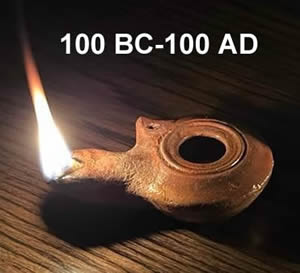 |
|
|
|||
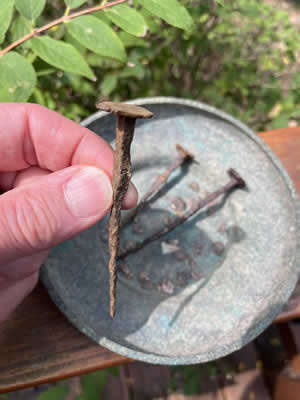 |
< 25-75 AD Roman Nails > |
 |
|
 |
< 25-75 AD Roman Nails > |
|
|
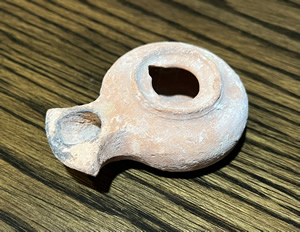 |
< Used around 30 AD, a Herodian oil lamp with a design produced from 63 BC – 200 AD
70-250 AD Oil Lamp >
|
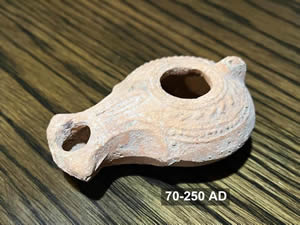 |
|
80-81 AD Vespasian < Obverse: Vespasian, wearing laureate, facing right. Latin Lettering: Reverse: Victory, draped, stepping left, > placing round shield on trophy, at base sits mourning Judaea, left. |
|||
|
10-90 AD Roman Lead Sling Shots or Ballista found in Israel
|
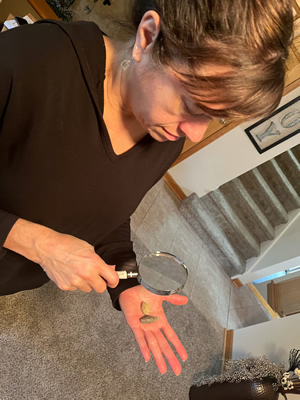 |
|
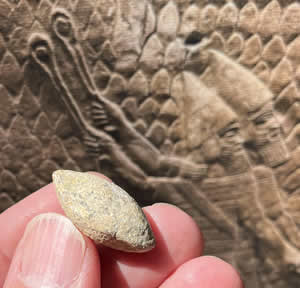 |
< 10-90 AD Roman Lead Sling Shot or Ballista found in Israel. An image of Assyrian soldiers slinging stones at Lachish in 701 BC is seen in the background.
10-90 AD Roman Lead Sling Shot or Ballista found in Israel with one blunt end that struck the target during a first century assualt. > |
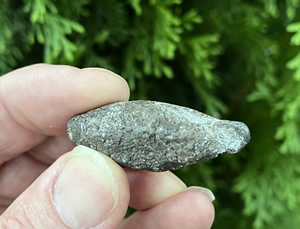 |
|
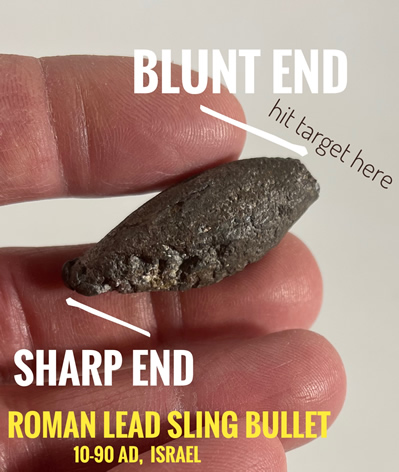 |
< 10-90 AD Roman Lead Sling Shot or Ballista with one blunt end that struck the target during a first century assualt and one end remaining sharp.
10-90 AD Roman Lead Sling Shot or Ballista with an ingraved monogram of the leader of the slingers. Often the name of the leader, the legion, a god or even an insult were engraved on the sling shot. Here it is the Latin letter "P" or the Greek letter "RHO". >. |
 |
|
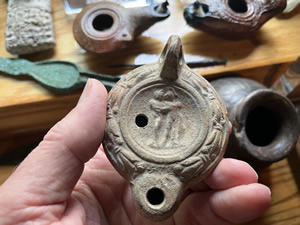 |
100 BC-100 AD Roman Oil Lamp
|
 |
|
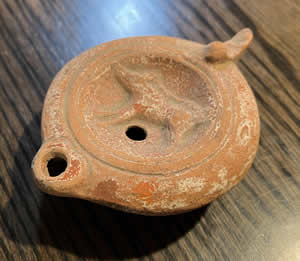 |
100 BC-100 AD Roman Oil Lamp
|
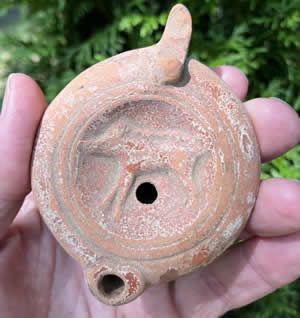 |
|
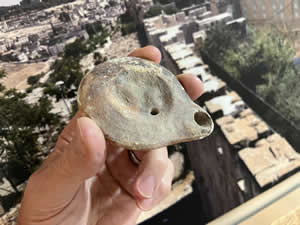 |
100 BC-100 AD Roman Oil Lamp <Top side of Roman Oil Lamp, 100 BC-100 AD Bottom side of the same Roman Oil Lamp > |
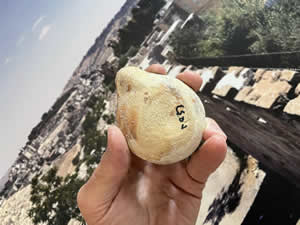 |
|
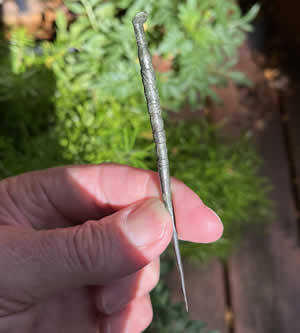 |
1st-3rd century AD - a bronze stylus with tapering lower body and ribbed collars. This sylus was used for writing on wax tablets and has a sub-circular eraser on one end used to smooth the wax surface. |
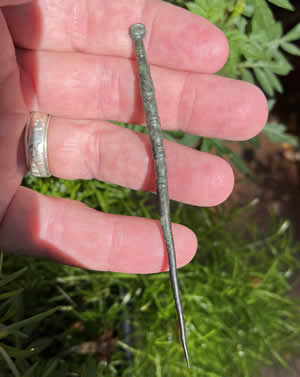 |
|
 |
Pendants, or pensilia, worn on the These bronze pensilia (or, pendants) hung on the ends of the pteruges (leather strips) that hung around the waist of the legionary. These are from the Roman Legions between 100-300 AD. |
 |
|
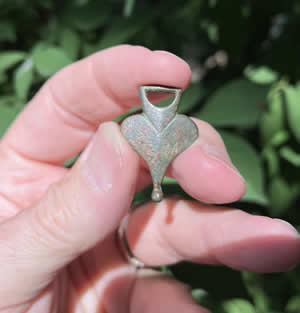 |
Pendants, or pensilia, worn on the < This pensilia still shows the red coloring of the Roman Legions This pensilia is slightly larger and shows wear from hanging on the attachment to the leather and belt. > |
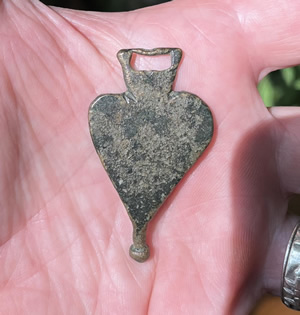 |
|
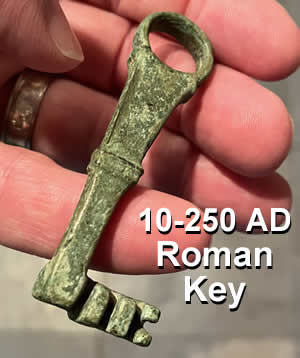 |
10-250 AD Roman Key Revelation 1:18 - |
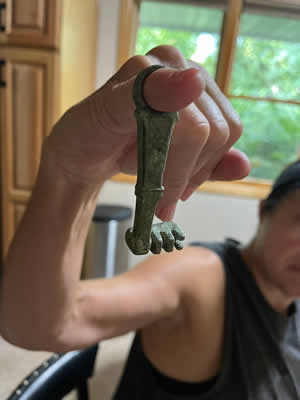 |
|
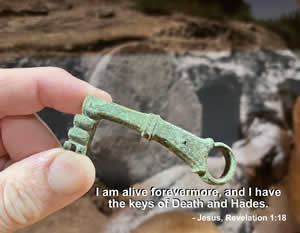 |
10-250 AD Roman Key Revelation 1:18 - |
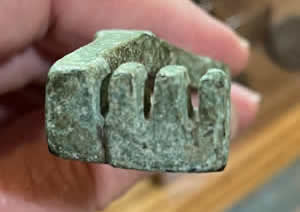 |
|
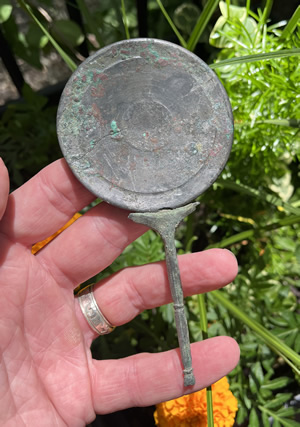 |
10-250 AD Roman Tinned Bronze Mirror with cast bronze handle
< Front of bronze Roman mirror from the time of the New Testament. The tinned bronze that reflected the image has aged off of this ancient mirror so a reflection is no longer visible.
|
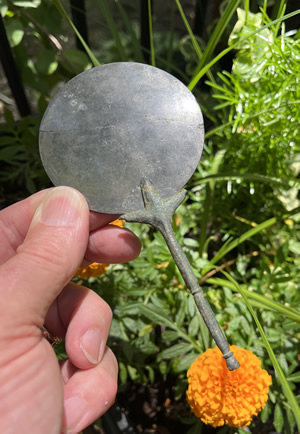 |
|
 Bronze mirrors alone had low reflectivity and poor relay of quality color. But, the bronze surface could also be tinned (as this mirror was) or coated with speculum metal (2/3 copper, 1/3 tin) providing a more reflective surface. This tin could be polished to reflect light, color and images. Corinth was famous for producing some of the finest bronze mirrors in antiquity (NICNT by Fee referring to a publication by the American School of Classical Studies in Athens, 1972). Paul writes in 1 Corinthians 13:12, “For now we see in a mirror dimly, but then face to face.” The word “dimly” is “anigma” in the Greek text meaning “a riddle”, which indicates “anigma” does not mean “bad”, “dim”, or “poor quality” at all. Paul is saying a mirror produces the enigma or the mysterious sight of seeing yourself without really seeing you. When you look at you in a mirror you are NOT seeing yourself “face to face”, but something very similar. (The English word “enigma” comes from this same Greek word “anigma”.) |
< Toni demonstrates the use of this 2,000 year old Roman mirror.
The front of the Roman mirror that once was covered with tin. >
|
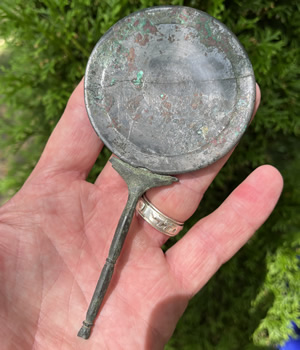 Paul was NOT saying the mirrors in Corinth were of poor quality. That would not be historically accurate and the Corinthians would not have made that connection in 55 AD. Corinth would not have thought they had bad mirrors any more than we think we have bad mirrors. Paul’s point was NOT to say we have a distorted or poor image of God, but to say we have an indirect image given to us by the Holy Spirit. Someday we will see God not through a reflection in a mirror, but face to face. (Speculum metal is a mixture of 2/3 copper and 1/3 tin which formed a white brittle alloy that could be polished to create a reflective surface.) |
|
NEW TESTAMENT COINS |
|||
|
|||
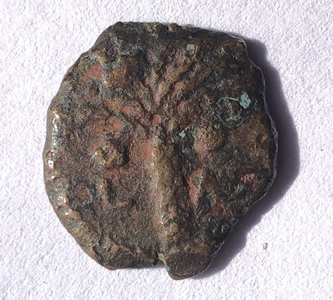 |
A "Widow's Mite" minted by the Roman Procurator of Judea Marcus Ambibulus 6-9 AD. The obverse sie shows a palm tree with the "L" and "M" inscribed on either side of the tree trunk.
The reverse side shows a barley ear with the inscription "KAICA" and "POC". |
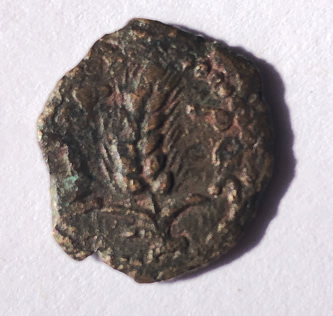 |
|
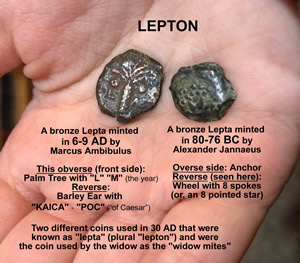 |
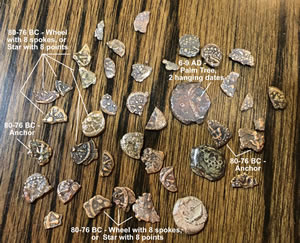 |
||
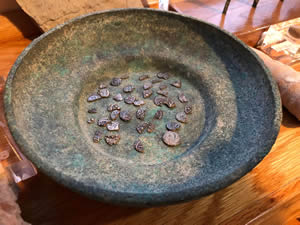 |
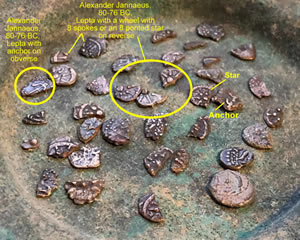 |
||
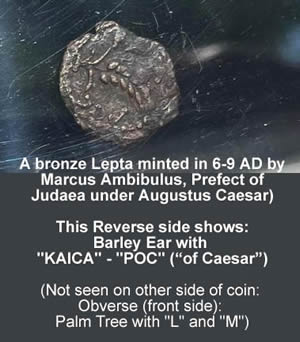 |
|||
MORE NEW TESTAMENT COINS |
|||
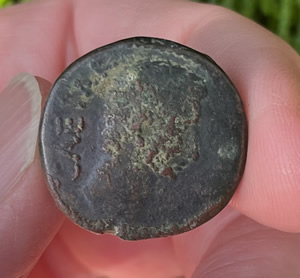 |
27 BC-14 AD Coin of Ceasar Augustus < The front or obverse side says "CAESAR" with an image of Caesar Augustus
The reverse side of a Ceasar Augustus coin with title "AUGUSTUS" written in a wreath on the back of this bronze coin. > |
 |
|
 |
37-4 BC minted by Herod the Great in Judea < The obverse side shows an anchor on the obverse side with the inscription
The reverse side shows two cornucopias. > |
 |
|
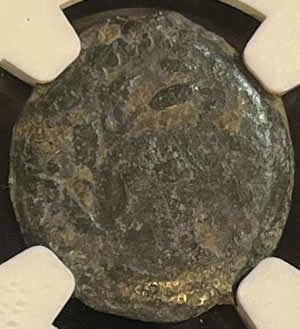 |
30 AD Coin prutah hammered; < Obverse: A wreath with an Reverse: A lituus (which is a a curved > augural staff, or a curved war-trumpet) in center encircled by inscription: TIBEPIOY KAICAPOC |
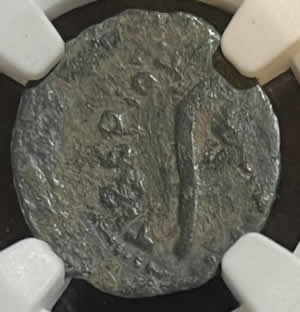 |
|
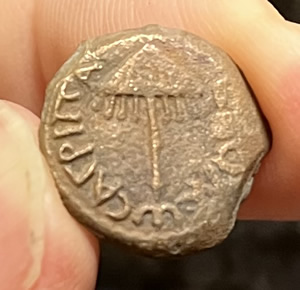 |
41-42 AD Herod Agrippa I - King of Judaea (37-44 AD) Bronze Prutah coin struck in Jerusalem < Obverse: Umbrella canopy with fringes was a symbol of power Reverse: LS means "year 6" of Agrippa, |
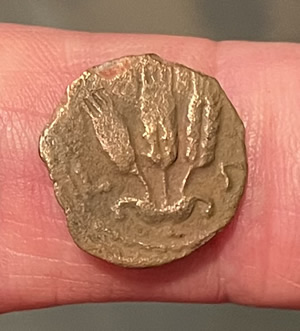 |
|
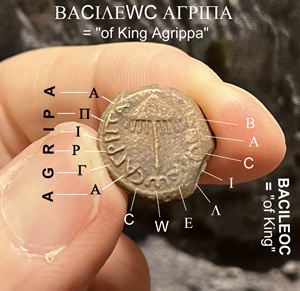 |
41-42 AD Herod Agrippa I |
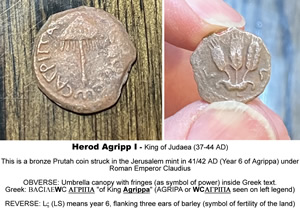 |
|
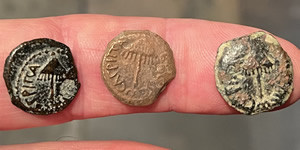 |
41-42 AD < Obverse: Umbrella canopy with fringes was a symbol of power Reverse: LS means "year 6" of Agrippa, |
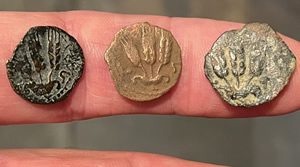 |
|
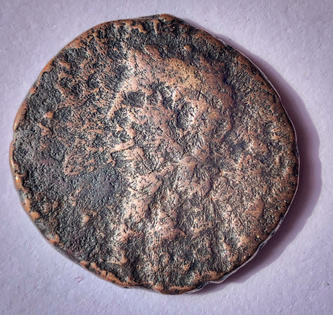 |
41-54 AD |
 |
|
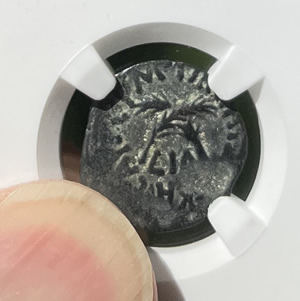 |
54 AD Antonius Felix, Governor of Judaea 52-59 AD under Roman Emperor Claudius. |
 |
|
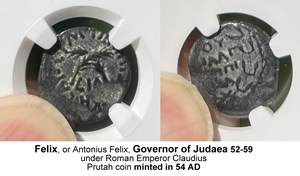 |
< 54 AD
|
59 AD > |
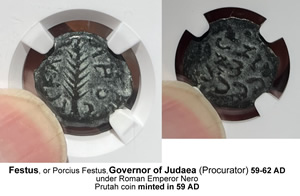 |
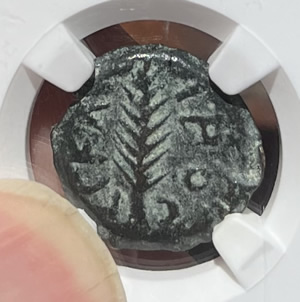 |
59 AD Porcius Festus, Governor of Judaea (Procurator) 59-62 AD under |
 |
|
 |
54-68 AD, < On the front, or obverse, side Nero is shown with a radiant head or multi-pointed crown like head piece sybolic of his diety. The reverse side of a coin minted by Nero showing Emperor Nero wearing an Egyptian headdress indicating he was the ruler or king of Egypt. > |
 |
|
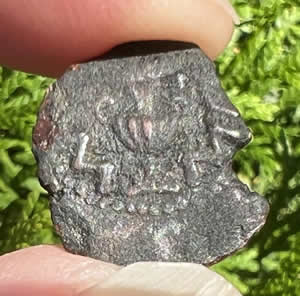 |
68 AD < Obverse: Amphora with Hebrew Inscription: "YEAR TWO" Reverse: Vine leaf on small branch > Many of these were found at Masada |
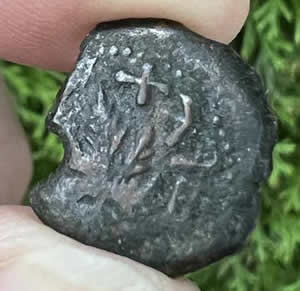 |
|
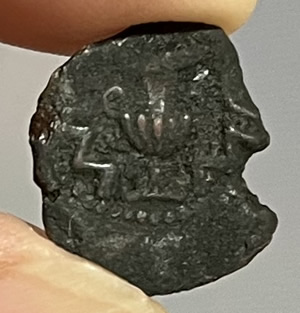 |
68 AD < Obverse: Amphora with Hebrew Inscription: "YEAR TWO" Reverse: Vine leaf on small branch > |
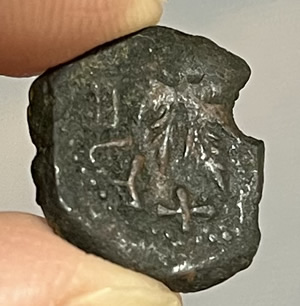 |
|
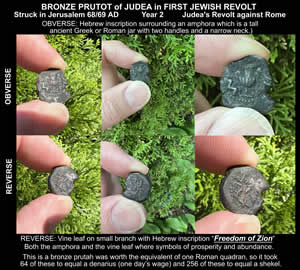 |
68 AD |
||
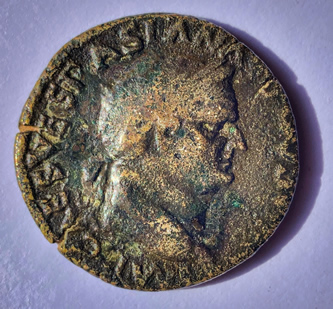 |
69-79 AD Emperor Vespasian < The obverse of the coin has an image of Vespasian and says "AUGUSTUS VESPASIAN". The reverse side shows an image of |
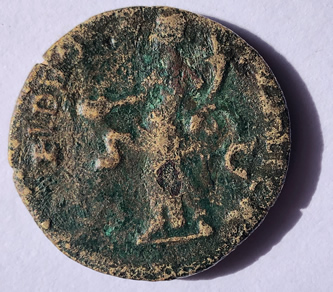 |
|
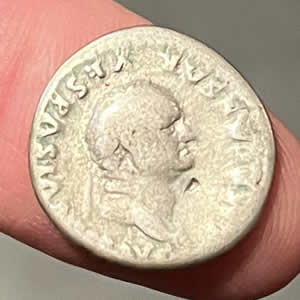 |
74 AD < Obverse: Vespasian, laureate Reverse: Vespasian, togate, seated. > PON MAX TR P COS V |
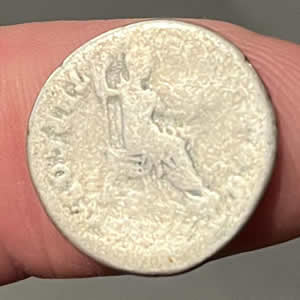 |
|
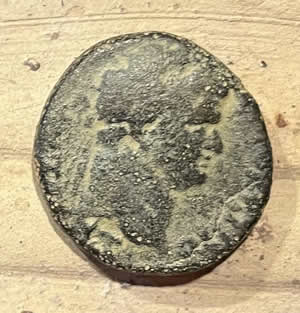 |
71-73 AD - Titus |
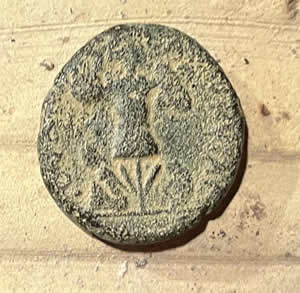 |
|
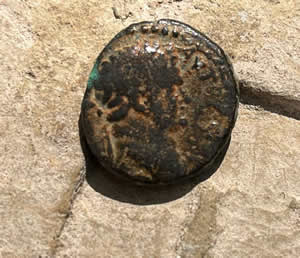 |
71-73 AD - Titus < Obverse: Titus laureate head (79-81 AD) Reverse: IOYAAIAC EAAXKYIAC |
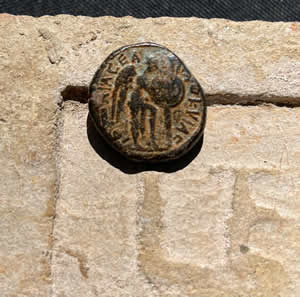 |
|
71-73 AD - Titus Details of Inscriptions
|
 |
||
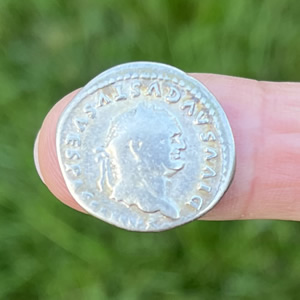 DIVVS AVGVSTVS VESPASIANVS or Divine Augustus Vespasian |
80-81 AD Vespasian < Obverse: Vespasian, wearing laureate, facing right. Latin Lettering: Reverse: Victory, draped, stepping left, > placing round shield on trophy, at base sits mourning Judaea, left. |
 Defeated Judea, or a Jewess, sits below a Roman trophy as Victory (Nike) hangs a shield. |
|
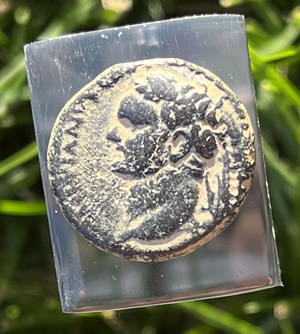 |
83 AD Domitian Judaea Capta minted Caesarea Maritima still recognizing the Romans defeat of the Jews in the wars of 66-70 AD < Obverse: Domitian laureate head Reverse: Minerva (Athena) stepping left |
 |
|
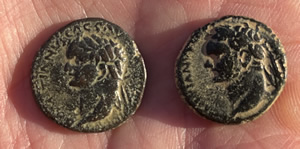 |
83 AD Domitian < DOMITIANUS CAES AUG GERMANICUS Reverse: Minerva (Athena) stepping left |
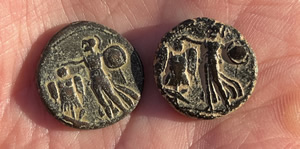 |
|
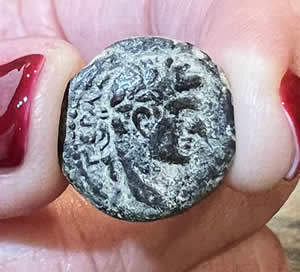 |
84 AD Agrippa II <Obverse: Head of Emperor Domitian Reverse: Nike standing, writing on shield resting on left knee; left foot resting on helmet.> |
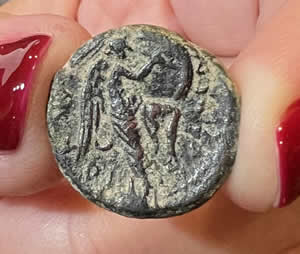 |
|
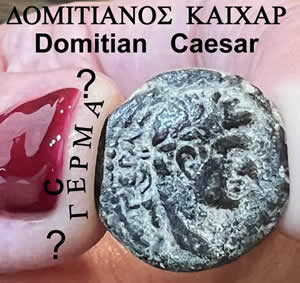 |
84 AD Agrippa II <Obverse: Head of Emperor Domitian with Greek inscription: Reverse: Nike writing on shield > |
||
 |
96 AD < Obverse: Domitian
Reverse: Moneta; inscribed with "S C" > |
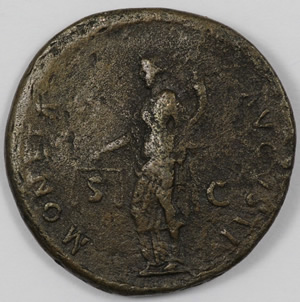 |
|
 |
69-96 AD The Flavian Dynasty |
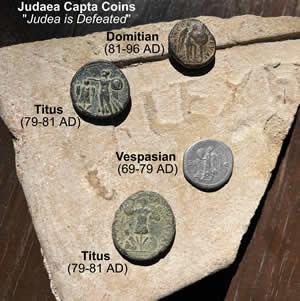 |
|
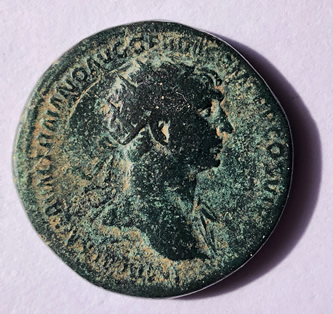 |
98-112 AD Emperor Trajan < The obverse, or front, side shows Trajan wearing a crown on his head.
The reverse side is Arabia Stands (SC) with the inscription "ARAB ADQVIS" >
|
 |
|
Papyrus Papyrus from the general time the New Testament was being written and similar to what the NT letters were written on. |
|||
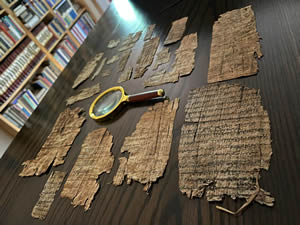 |
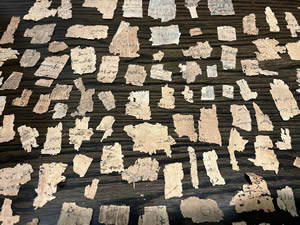 |
||
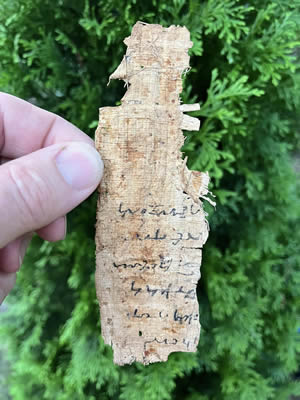 |
 |
||
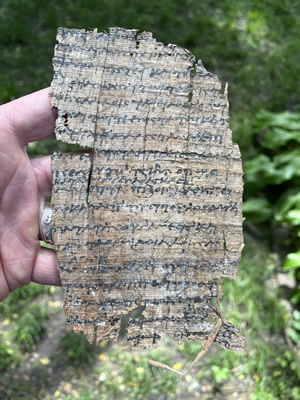 |
 |
||
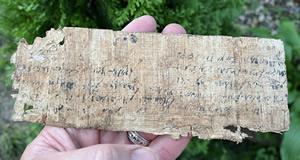 |
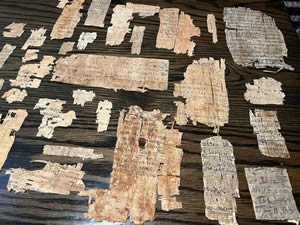 |
||
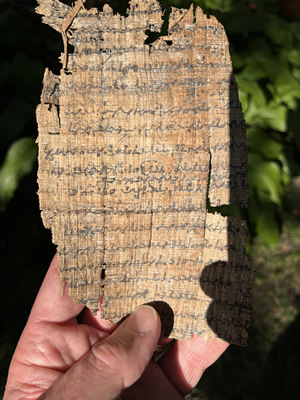 |
 |
||
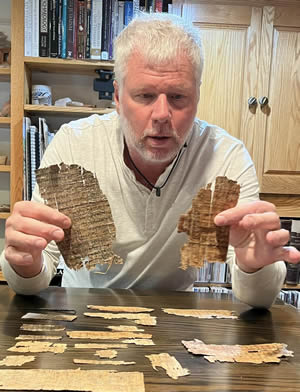 |
|||
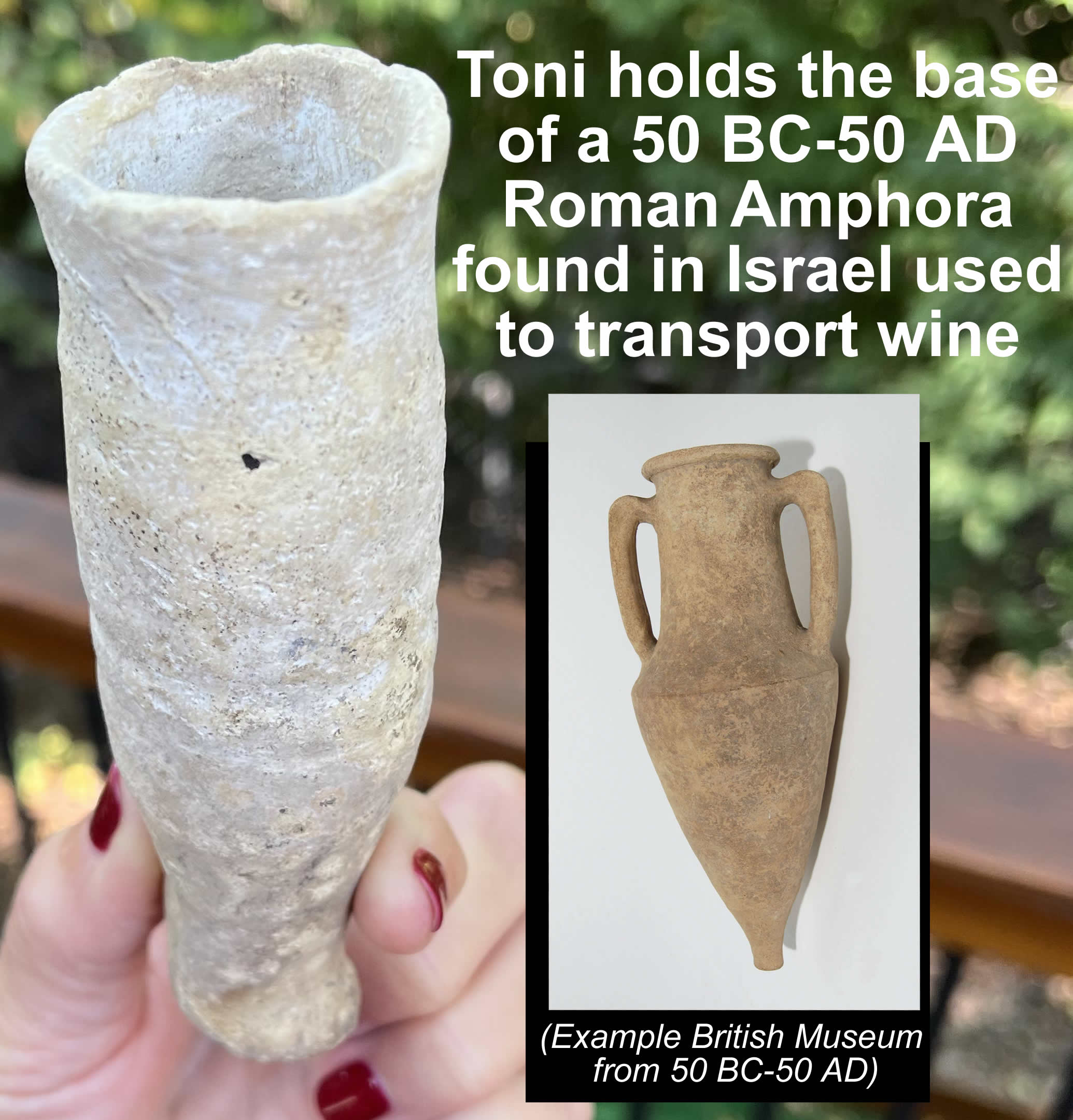 |
50 BC-50 AD Roman Amphora base |
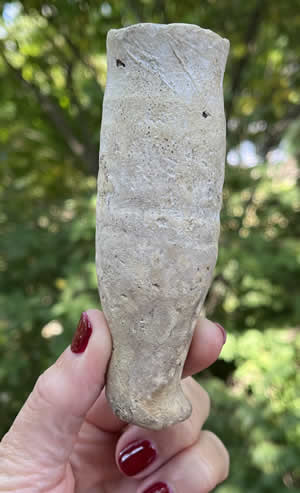 |
|
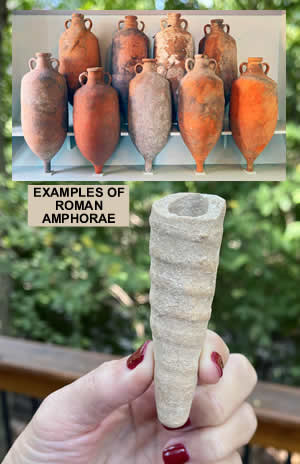 |
50 BC-50 AD Amphora Base Base of a ceramic amphora jar used to transport Roman wine |
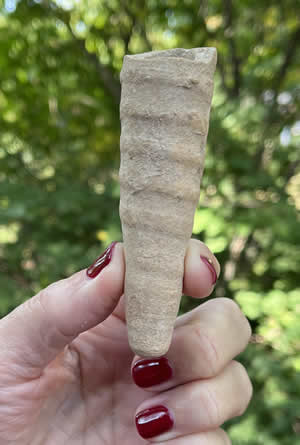 |
|
BULLA |
|||
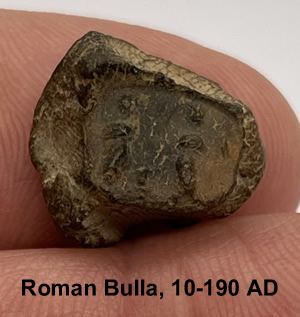 |
10-190 AD Roman Clay Bulla < Obverse side shows a man standing on left facing a goddess Reverse side shows fibers of the papyrus document this bulla sealed around 100 AD > |
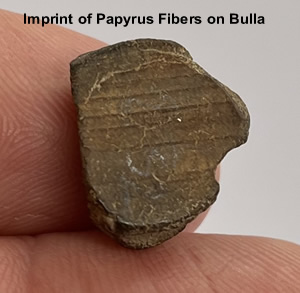 |
|
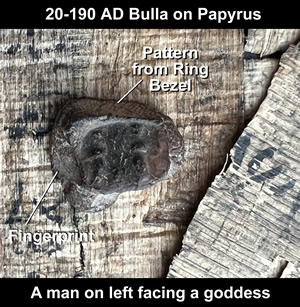 |
10-190 AD Roman Clay Bulla < Papyrus from the same time period with the obverse of a bulla that sealed a papyrus document around 100 AD Bronze Roman rings from 100-500 AD used for personalized sealing of documents in bulla.> |
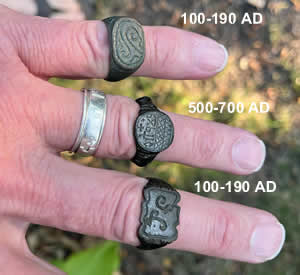 |
|
Photos were taken by Galyn Wiemers All images may be downloaded, |
For Bible teaching audio, video, notes and study tools visit Generation Word's home page at www.generationword.com |
||